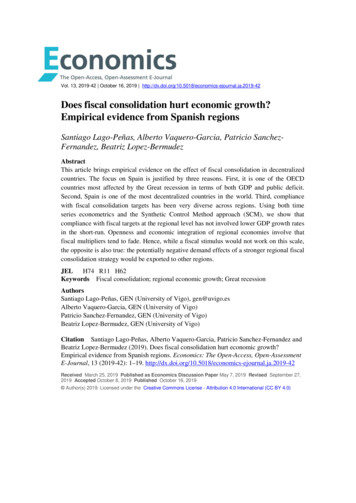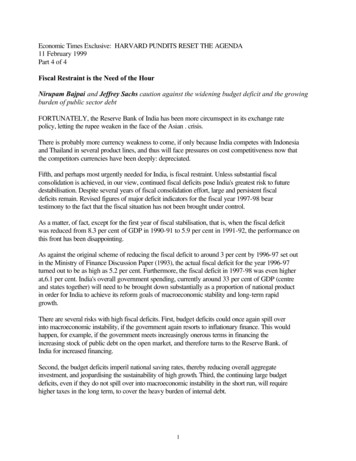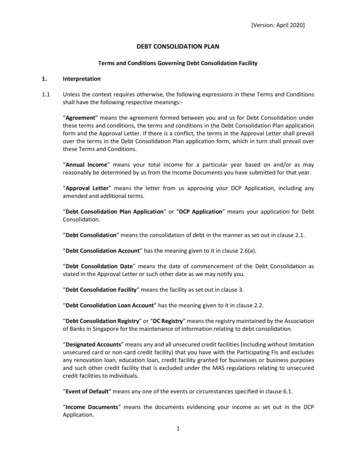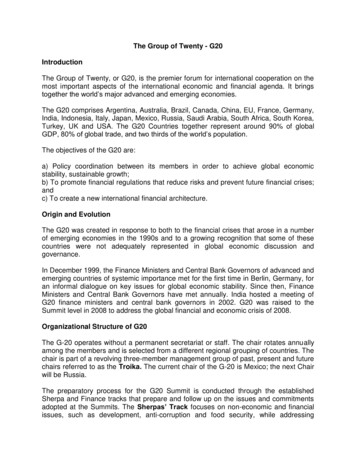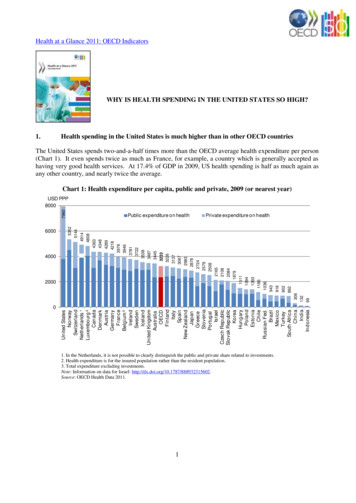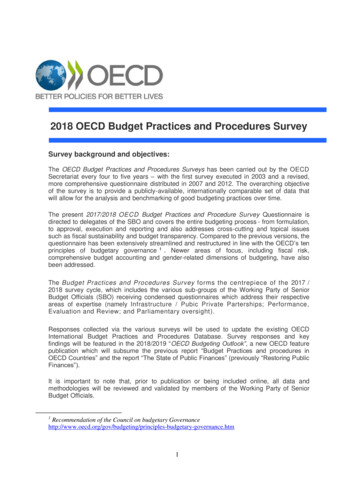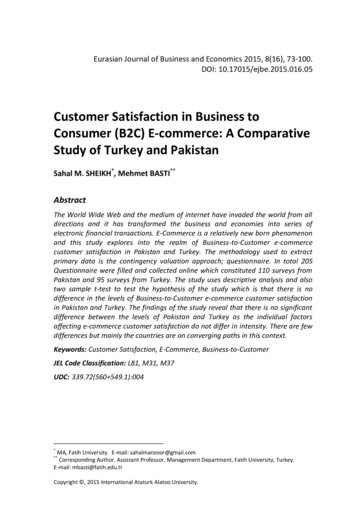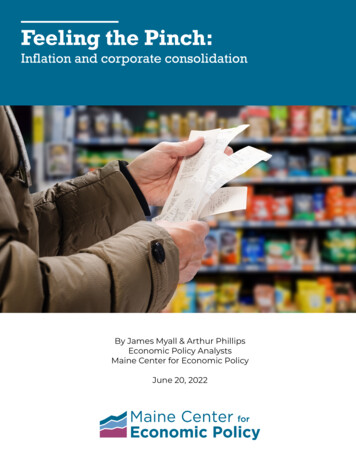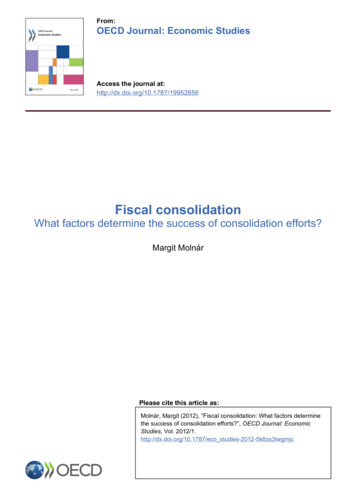
Transcription
From:OECD Journal: Economic StudiesAccess the journal at:http://dx.doi.org/10.1787/19952856Fiscal consolidationWhat factors determine the success of consolidation efforts?Margit MolnárPlease cite this article as:Molnár, Margit (2012), “Fiscal consolidation: What factors determinethe success of consolidation efforts?”, OECD Journal: EconomicStudies, Vol. 2012/1.http://dx.doi.org/10.1787/eco studies-2012-5k8zs3twgmjc
This document and any map included herein are without prejudice to the status of orsovereignty over any territory, to the delimitation of international frontiers and boundaries and tothe name of any territory, city or area.
OECD Journal: Economic StudiesVolume 2012 OECD 2013Fiscal consolidation:What factors determine the successof consolidation efforts?byMargit Molnar*The global economic and financial crisis exacerbated the need for fiscalconsolidation in many OECD countries. Drawing lessons from past episodes of fiscalconsolidation, this study investigates the economic environments, political settingsand policy measures conducive to fiscal consolidation and debt stabilisation usingprobit, duration, truncated regression and bivariate Heckman selection methods.The empirical analysis builds on the earlier literature and extends it to include newaspects that may be of importance for consolidating governments. The empiricalanalysis confirms previous findings that the presence of fiscal rules – expenditure orbudget balance rules – is associated with a greater probability of stabilising debt.Crucial in determining the causal link behind the association, the results also revealan independent role for such rules over and above the impact of preferences for fiscalprudence. Also, while the analysis confirms that spending-driven adjustments visà-vis revenue-driven ones are more likely to stabilise debt, it also reveals that largeconsolidations need multiple instruments for consolidation to succeed. Sub-nationalgovernments, in particular state-level governments can contribute to the success ofcentral government consolidation, if they co-operate. To ensure that state-levelgovernments do co-operate, having the right regulatory framework with theextension of fiscal rules to sub-central government levels is important.JEL classification: E62; H2; H5; H6; H7Keywords: Fiscal consolidation; taxation; government spending; fiscal rules; fiscalfederalism* Margit Molnar (Margit.Molnar@oecd.org). At the time of writing the author was a member of theEconomics Department of the OECD. This is a background paper for the OECD’s project on FiscalConsolidation (see Sutherland et al., 2012 for the main paper). The author is indebted to theparticipants of the Working Party meeting, Jürgen von Hagen, Eckhard Wurzel, Hansjörg Blöchliger,Peter Höller and Douglas Sutherland for useful comments and suggestions and to Susan Gascard forexcellent editorial support.123
FISCAL CONSOLIDATION: WHAT FACTORS DETERMINE THE SUCCESS OF CONSOLIDATION EFFORTS?In the aftermath of the economic and financial crisis many OECD countries facesubstantial fiscal consolidation needs. In this context, taking stock of past consolidationepisodes can provide insights into what policy and institutional measures were mostconducive to successful consolidations. A consolidation episode is a period of fiscaladjustment, whose start and end are defined by thresholds in terms of the size of thechange in the underlying cyclically-adjusted primary balance. The period between the startand the end is the length of the episode expressed in years and the cumulated improvementin the underlying cyclically-adjusted primary balance during the consolidation episode isthe size of the consolidation, expressed as a share of potential GDP. The intensity, in turn,is the average improvement in the underlying cyclically-adjusted primary balance (asa ratio of potential GDP) in a unit time period, which is a year. The intensity of aconsolidation episode is obtained by dividing its size by its length. The success ofconsolidation is defined here as debt stabilisation one, two and three years after the end ofthe consolidation episode.The analysis of past consolidation episodes between 1960-2009 builds on and extendsearlier OECD work by Ahrend et al. (2006) and Guichard et al. (2007). It uses probit, duration,truncated regression and bivariate Heckman selection methods to investigateconsolidations, highlighting the different ingredients that affect how much consolidationis undertaken and whether it is successful in terms of stabilising debt. The estimationsconsider five aspects of fiscal consolidations: What conditions make governments start fiscal adjustments? What determines how long adjustments last? What determines the size of adjustments? What determines the intensity (the annual average consolidation over the consolidationepisode) of the adjustment? What makes fiscal retrenchments successful in the sense of stabilising the debt/GDP ratio?The study, while building on earlier literature, attempts to obtain robust results usinga wide sample of definitions and measures of consolidation and its success. Also, itexplores most aspects of consolidations seen in the literature and investigates the impactof a large set of conditions including domestic and external economic and politicalsettings, monetary and exchange rate environments and fiscal institutions. The mainfindings, summarised in Table 1, are the following:124 Fiscal rules are, in general, associated with fiscal consolidation episodes that aresuccessful in stabilising debt, though there is no evidence that they influence the size orthe intensity of consolidation. Budget balance rules appear to lengthen the duration ofconsolidations. The composition of consolidation measures seems to be related to its success.Expenditure based consolidations appear to be more effective in stabilising debt. However,OECD JOURNAL: ECONOMIC STUDIES – VOLUME 2012 OECD 2013
FISCAL CONSOLIDATION: WHAT FACTORS DETERMINE THE SUCCESS OF CONSOLIDATION EFFORTS?the specific consolidation measures that lead to success seem to differ by the type ofconsolidation (i.e. small or large, gradual or “cold turkey”) and by the horizon of debtstabilisation (i.e. debt stabilises one, two or three years after the consolidation episodeends). Very large consolidations tend to be achieved by multiple instruments, includingboth revenue and spending items. Strong growth appears to matter for stabilising debt, though less for the size or intensity ofconsolidations. Low growth rates may lead to protracted consolidation episodes. Declining interest rates seem to increase the probability of success and the duration ofconsolidation, though have no robust impact on the start, size or intensity of theconsolidation. The political setting also appears to matter for the success of consolidation: non-centristgovernments are less likely to stabilise debt than those closer to the centre. Theorientation of government does not seem to affect the duration of consolidation. In somespecifications, strong governments further from the centre tend to engage in smaller andless intensive consolidation. Newly-elected governments seem to be more likely to start a fiscal adjustment programmeand have a positive effect on duration. Consolidations by state-level governments tend to increase the probability of success ofcentral government retrenchment efforts, but this is not the case for consolidations at thelocal government level (not reported in Table 1).The rest of this study is structured as follows: Section 1 summarises the main findingsfrom the empirical literature. This is followed by a short discussion of the methods used,the main definitions of consolidation episodes and data used in the analyses (Section 2).Section 3 presents detailed results for the econometric analysis of different aspects ofconsolidation and, finally, Section 4 concludes by discussing the implications of thefindings for fiscal consolidation.1. A review of the literatureThe literature on fiscal consolidation episodes has identified major determinants ofthe likelihood of starting fiscal consolidation and its success, as well as several otherattributes. The major questions of interest addressed by the fiscal consolidation episodeliterature are i) in which circumstances are fiscal adjustments likely to start and ii) inwhich circumstances are they successful. For the start of consolidations, initial conditionsincluding the macroeconomic environment and political economy settings appear to bedecisive. For the likelihood of success, a broader set of conditions have been tested. Notsurprisingly, given that the channels through which policy effects come through may differacross episodes, the literature is inconclusive on some of the policies. A large part of theliterature focuses on the composition of consolidation, primarily whether it should bebased on expenditure cuts or revenue increases. While there seems to be consensus on thelarger role for expenditure cuts, the results are less homogenous at the more disaggregatedlevel. Tackling politically-sensitive budgetary items, however, seems to be a crucialingredient of successful consolidations. Fewer studies deal with the role of the policy mixor structural and institutional conditions in determining the success of consolidation.Moreover, the applicability of past consolidation experiences may be limited aspolicymakers now face additional challenges such as repairing banking sectors and copingwith weak global demand. The present consolidation may also be distinct owing to itsOECD JOURNAL: ECONOMIC STUDIES – VOLUME 2012 OECD 2013125
FISCAL CONSOLIDATION: WHAT FACTORS DETERMINE THE SUCCESS OF CONSOLIDATION EFFORTS?Table 1. Summary of the empirical resultsPolicy variablesStartDurationSizeIntensitySuccessFiscal rulesExpenditure rule Budget balance rule Expenditure and balanced budget rule Strength of fiscal rules (for the EU) Composition of consolidationSpending cut versus revenue increase share . . Housing and community amenities spending cut share . Social protection spending cut share . . Economic environment variablesGDP growthExchange rate (lagged change) .----.Interest rate (lagged change)Interest rate differential (lagged change) .-.- . . . ---. . . . ------- .------Length of consolidationOECD30 budget balance/GDP (lagged change) . .- . Implicit interest on government debt (lagged change)Inflation (lagged) . Initial debt ratio .-. . Initial underlying primary budget balance---------- .- . --Change in the debt ratio (lagged) . . . ERM. . . .EU 1992-1998 .- -EU 1999-2009 . . .Political setting variablesElections (lagged). . .- Strong left-leaning government-.- . -.-.-.----Strong right-leaning government.---- . -. -.--Notes: The direction of significant effects is indicated by plus and minus signs, a non-significant effect by a dot.In the columns for the start, duration, size and intensity of consolidation, the results for five thresholds are indicatedin the following order: i) very small: continuous improvement in the budget balance (i.e. the episode lasts as long asthe budget balance improves), ii) medium-sized: 1 percentage point fall in the budget balance/GDP ratio in a singleyear or in two years, with at a minimum a 0.5 percentage point fall in the first year, iii) large 1: 1.5 percentage pointsfall in the budget balance/GDP ratio in a single year or in two years with at a minimum a 1.25 percentage points ineach, iv) large 2: 1.5 percentage points fall in the budget balance/GDP ratio in a single year or in three years with lessthan a 0.5 percentage point deterioration in any year and v) very large: 2 percentage points fall in the budget balancein a single year or in two years with a minimum of 1.5 percentage points in each.In the column for success, the signs are indicated for three different definitions of success in the following order:i) debt stabilises one year; ii) two years; and iii) three years after the consolidation episode ends. The fiscal rulevariables in the success equations are entered sequentially.The methods used are: probit for the start and survival analysis for the duration of the consolidation, truncatedregression for the analysis of the size and intensity of the consolidation and the bivariate Heckman selection modelfor the success of a consolidation in stabilising debt.required size and how widespread consolidation needs are. These features may imply theneed for a broader set of policy tools to achieve consolidation.Fiscal consolidation is more likely to be launched when fiscal conditions are weak andthe domestic economy is doing well relative to other economies (Table 2). Weak publicfinance conditions are found to be an important trigger of consolidation (Barrios et al., 2010;Guichard et al., 2007; European Commission, 2007; Von Hagen and Strauch, 2001). In contrastto the intuition that fiscal actions only take place when the authorities are forced bycircumstances to embark on a consolidation path, von Hagen and Strauch (2001) and theEuropean Commission (2007) found that positive output gaps increase the probability of126OECD JOURNAL: ECONOMIC STUDIES – VOLUME 2012 OECD 2013
FISCAL CONSOLIDATION: WHAT FACTORS DETERMINE THE SUCCESS OF CONSOLIDATION EFFORTS?Table 2. A literature review of what determines the start of fiscal consolidationDependent variable: Start of a consolidationepisode (binary)Initial budget balance (CAPB)Guichardet al. (2007)EC(2007)––Debt-to-GDP ratiovon Hagenand Strauch(2001) Increasing debt ratio Weak international environment–Tight monetary conditions in the previous year(index)–Increase in OECD structural government balance0Effective budgetary procedures Exchange rate depreciation0 0Employment protection legislation dummy0Unemployment benefits dummy Labour market reform dummy Product market reform dummyMethod used00Pension reform (Rodolfo de BenedettiFoundation), dummyNumber of episodes– Size of majority in parliamentTime period Fiscal rulesNumber of countriesBarrioset al.(2010) Heckman2-step Output gapLong-term interest rates(domestic-foreign reference)Barrioset al.(2010)probit Need for adjustment (difference between currentCAB& the one needed to bring the debt ratioto zero over 30 yearsElectionsAhrendet al. (2006)0242720 robitProbitHeckman 2-stepNote: The negative and positive signs mean negative and positive effect, respectively, while a zero means nosignificant effect was found.launching a retrenchment.1 Von Hagen and Strauch (2001) also found a negative impact forthe international environment, which, combined with the positive coefficient on domesticcyclical conditions, implies that governments are more likely to undertake consolidationefforts when the domestic economy is doing well relative to other economies. Von Hagenand Strauch (2001) also found evidence of peer pressure: an increase in the OECD structuralgovernment balance has a strong positive effect on the likelihood to start a consolidationThe duration of fiscal consolidations is affected by the composition of the adjustment,initial conditions and consolidation fatigue. Von Hagen et al. (2002) found that when outputwas below potential but improving, a tightening fiscal stance in other countries and anincreasing contribution by spending, in particular transfers and wage expenditures, to thetotal consolidation increase the likelihood that the consolidation episode will continue.Guichard et al. (2007) and Ahrend et al. (2006) confirmed the importance of a negativeoutput gap to continuing an adjustment programme. On the other hand, Tsibouris et al.(2006) found no significant effect. Von Hagen et al. (2002) also found evidence ofconsolidation fatigue by showing that the longer an episode lasts, ceteris paribus, thegreater the likelihood that the adjustment process will be reversed. This finding wasconfirmed by Guichard et al. (2007) and Ahrend et al. (2006).OECD JOURNAL: ECONOMIC STUDIES – VOLUME 2012 OECD 2013127
FISCAL CONSOLIDATION: WHAT FACTORS DETERMINE THE SUCCESS OF CONSOLIDATION EFFORTS?In general, gradual consolidations tend to be more successful than a cold showeradjustment, but at high and sharply rising debt levels and in a low-growth environment acold shower may be more effective (Barrios et al., 2010; European Commission, 2007). Agradual retrenchment, however, is not successful in the case of consolidations followingsharp debt increases. Moreover, Barrios et al. (2010) found that monetary and economicconditions may be playing a role in determining the consolidation strategy. Cold showersmay be the right choice if initial debt levels and interest rates are high and GDP growth low,while the opposite conditions would suggest proceeding gradually.Boltho and Glyn (2006) highlight the differences in consolidation efforts in the 1980sand 1990s: while in the 1980s, inflation and balance-of-payment problems constituted thegreatest threat following the oil shocks, in the 1990s, long-term debt sustainability becamethe major concern. In addition, the run up to the EMU provided an impetus toconsolidation efforts. Among the few studies looking at the impact of financial crises onthe start or the probability of success of fiscal consolidations, Barrios et al. (2010) found thatthe fall-out from the crises may hinder the necessary retrenchment. Undertakingconsolidation once the financial crisis is resolved and choosing a cold shower strategyincreases the chance to succeed. This may be related to the use of public funds that therepair of the financial sector often necessitates and as long as the cost of bailouts isunclear, fiscal consolidation programmes may not be credible.The impact of high debt levels on the probability of successful consolidation hingesupon model specifications. For example, Barrios et al. (2010) using two different approachesfind either a positive or negative net impact of debt.Monetary conditions including exchange rate and interest rate movements also havea bearing on fiscal consolidation, though the literature exploring this is scant andinconclusive. Exchange rate depreciation may support the consolidation process by leadingto competitiveness gains and export-led growth. This channel is more likely to work forsmall open economies. The experience of OECD countries shows, however, thatdepreciation does not necessarily help consolidations succeed. Several studies find nosignificant impact (Alesina and Perotti, 1997, Guichard et al., 2007 and Barrios et al., 2010) ora significant albeit small positive impact (Lambertini and Tavares, 2005). Lambertini andTavares (2005) observed that exchange rate depreciation, which boosted competitiveness,often preceded fiscal consolidation episodes in OECD countries over 1970-99. A fall inrelative unit labour costs before and during successful consolidations boostedcompetitiveness (Alesina and Perotti, 1997). While nominal depreciation was observed inboth successful and unsuccessful consolidation episodes, it was only in the case ofsuccessful ones where nominal depreciations had an impact on competitiveness. This maybe related to the composition of fiscal adjustments, in particular the greater weight givento cuts in government wages and employment in successful consolidations, therebyinducing wage moderation. Ahrend et al. (2006) found that monetary policy easing at theinitial stage of fiscal consolidation contributes to offset the contractionary impact of fiscalconsolidation. Von Hagen and Strauch (2001) found that monetary easing may enticegovernments to start fiscal adjustments, but this does not necessarily lead to successfuladjustments.The composition of fiscal consolidation matters for the probability of success ofconsolidations: retrenchments based on expenditure cuts are found to be more effective(Alesina and Ardagna, 1998, 2009; von Hagen et al., 2002; Guichard et al., 2007; Barrios et al.,128OECD JOURNAL: ECONOMIC STUDIES – VOLUME 2012 OECD 2013
FISCAL CONSOLIDATION: WHAT FACTORS DETERMINE THE SUCCESS OF CONSOLIDATION EFFORTS?2010). A possible explanation for the higher effectiveness of spending cuts versus taxincreases is that the former are often coupled with reforms that enhance the effectivenessof budgetary procedures (European Commission, 2007). Von Hagen and Strauch (2001)examined the probability of a consolidation to be expenditure based and found that a smalloutput gap, both domestically and internationally, a tight fiscal stance in other countriesand a high debt-to-GDP ratio increase the probability of a consolidation episode to beexpenditure based. Revenue-based consolidations can also be effective, if there is room toincrease the revenue-to-GDP ratio, in particular if the revenue types that are less harmfulfor growth (such as user fees, environmental taxes, property taxes and value-added taxes)are under-exploited (Tsibouris et al., 2006). Surprisingly, Alesina and Perotti (1995) foundthat the small share of successful adjustments due to increases in tax revenues comesalmost exclusively from corporate income taxes and not indirect taxes.Past empirical work typically finds that cutting current government spending is moreconducive to successful consolidation (Alesina and Ardagna; 2009). Guichard et al. (2007)found that social spending and transfers are areas where spending cuts should be focusedto achieve a successful consolidation. Alesina and Perotti (1995 and 1997) found that fiscaladjustments should focus on cuts in welfare spending and government wages, if they areto be successful. However, European Commission (2007) found, that in the 1990s, thepositive impact of cutting primary expenditure on the likelihood of success becameweaker. This could be due to past consolidations harvesting the “low hanging fruits”.Interestingly, if the analysis focuses on the European Union (27 members), spending onsocial protection, health and education continue to increase during consolidation periods,while the bulk of the cuts are done in economic affairs (which comprise subsidies, grossfixed capital formation, capital transfers and intermediate consumption) and housing andcommunity amenities (European Commission, 2007).2The literature is not conclusive on which types of fiscal rules and institutions affectconsolidation programmes. Guichard et al. (2007) found a beneficial effect from acombination of expenditure and budget balance rules. The European Commission (2007),on the contrary, found no significant impact of expenditure rules in the European Union,though this study did not verify the combined effect with budget balance rules. However,effective budgetary procedures appear to increase the probability of success (EuropeanCommission, 2007). Barrios et al. (2010) did not find a significant impact of budget deficitrules on the likelihood of successful consolidation.Successful consolidations may be accompanied by changes in the distribution ofincome. Alesina and Perotti (1997) and Alesina and Ardagna (1998) observed that duringsuccessful consolidations, the profit share often increases. Alesina and Ardagna (1998)showed that the profit share increases not only during but also in the aftermath ofconsolidations. Mulas-Granados (2005) found that fiscal consolidations are associated withhigher income inequality, though less so for revenue-based adjustments than forexpenditure-based ones.Few studies find convincing evidence on how political factors affect consolidation.Alesina and Perotti (1995) found that coalition governments are mostly unsuccessful inattaining lasting adjustment. The same authors also found that left- and right-winggovernments are equally likely to carry out successful adjustments, while centristgovernments are less likely to do so. Guichard et al. (2007) showed that consolidations aremore likely to start after elections in OECD member countries, while the EuropeanOECD JOURNAL: ECONOMIC STUDIES – VOLUME 2012 OECD 2013129
FISCAL CONSOLIDATION: WHAT FACTORS DETERMINE THE SUCCESS OF CONSOLIDATION EFFORTS?Commission (2007) did not find a significant effect for the EU countries over a similar timeperiod. Alesina and Perotti (1995) did not find a significant impact of the closeness ofelections on either the likelihood of strong adjustments or their success.2. Empirical approach, definitions and dataMost of the literature applies similar estimation techniques to identify the majordeterminants of success or failure and various attributes of fiscal consolidations. The mainestimation tools include probit, duration models and OLS, and more rarely the Heckmanprobit two-step estimator. Estimates of the determinants of the start and success ofconsolidations may be biased if not controlling for the correlation between the decision toconsolidate and the likelihood to achieve a successful consolidation (Barrios et al., 2010). Incontrast to this standard set (or some subsets of it) of estimation methods applied in theliterature to investigate past consolidation episodes, there is considerable variation acrossthe measures of fiscal consolidation, the definitions of the start of consolidation, the sizeof consolidation and of what constitutes a successful consolidation (Table 3).Earlier studies such as Alesina and Perotti (1995, 1996) and Alesina and Ardagna (1998)defined a fiscal consolidation episode using the so-called Blanchard index, whichcalculates a cyclically-adjusted budget balance assuming an unchanged unemploymentrate with respect to the previous year. In more recent studies the cyclically-adjustedprimary balance is used (Tsibouris et al., 2006). The major shortcoming of the cyclicallyadjusted primary balance is that it can also reflect one-offs and accounting distortions(Koen and van den Noord, 2005), revenue fluctuations due to asset prices (Girouard andPrice, 2004) and growth surprises (Larch and Salto, 2005). To address these issues, pastanalyses have typically only used large changes. There is, however, a trade-off in settingthresholds high as it can exclude longer periods of moderate adjustment. To overcomemany of these issues, in the analyses below, the cyclically-adjusted underlying primarybalance is used. This measure, in addition to correcting for fluctuations in business cycles,also takes into account one-offs. Different definitions of the budget balance were used inthe analysis (such as the cyclically-adjusted underlying primary balance, the cyclicallyadjusted primary balance, the unadjusted primary balance, adjusted fiscal balance and theunadjusted fiscal balance), though only results for the cyclically-adjusted underlyingprimary balance are reported in the paper. The results obtained when using the cyclicallyadjusted primary balance were similar.The definition of a consolidation episode is crucial as different thresholds and budgetdata may lead to different findings. Accordingly, to obtain robust results, five thresholdsare used. These thresholds cover several types of consolidation episodes from very smallones defined as any improvement in the budget balance that may occur over a number ofyears to very large ones of at least 2 percentage points of GDP in a given year. Thethresholds applied for consolidation episodes are: i) very small: continuous improvementin the budget balance (i.e. the episode lasts as long as the budget balance improves),ii) medium-sized: 1 percentage point fall in the budget balance/GDP ratio in a single year orin two years, with at a minimum a 0.5 percentage point in the first year, iii) large 1:1.5 percentage point fall in the budget balance/GDP ratio in a single year or in two yearswith at a minimum a 1.25 percentage point in each, iv) large 2: 1.5 percentage point fall inthe budget balance/GDP ratio in a single year or in three years with less than a0.5 percentage point deterioration in any year and v) very large: 2 percentage point fall inthe budget balance in a single year or in two years with a minimum of 1.5 percentage130OECD JOURNAL: ECONOMIC STUDIES – VOLUME 2012 OECD 2013
Start of consolidationContinuationDefinition 1Ahrend et al., 2006At least 1 percentage point of potential At least 1 percentage point of potential Cyclically-adjusted primary balanceGDP in one yearGDP in two years with at leastimproves (can decline 0.3 percentage0.5 percentage point in the first yearpoint in a year if in the following year itincreases by more than 0.5 percentagepoint)Alesina and Perotti, 1995Blanchard fiscal impulse is between– 1.5 and – 0.5% of GDPAlesina and Ardagna, 2009At least 1.5 percentage pointsof GDP in one yearAlesina and Perotti, 1997At least 1.5 percentage pointsof GDP in one yearAt least 1.5 percentage pointsof GDP in 2 years with each morethan 1.25 percentage pointsArdagna, 2009At least 2 percentage pointsof potential GDP in one yearAt least 2 percentage pointsof potential GDP in two years with eachmore than 1.5 percentage pointsBarrios et al., 2010At least 1.5 percentage pointsof potential GDP in one yearAt least 1.5 percentage pointsof potential GDP in three years,with no annual deterioration largerthan 0.5 percentage pointEC, 2007At least a 1.5 percentage pointsof GDP in one yearAt least 1.5 percentage pointsof potential GDP in three years,with no annual deterioration largerthan 0.5 percentage pointGuichard et al., 2007At least 1 percentage pointof potential GDP in one yearAt least 1 percentage pointCyclically-adjusted primary balanceof potential GDP in two years with each improves (can decline 0.3 percentagemore than 0.5 percentage pointspoint in a year if the following year itincreases by more than 0.5 percentagepoint)Tsibouris et al., 2006Uninterrupted improvementin the primary budget balanceSuccessCyclically-adjusted primary balancestops increasing or improves by lessthan 0.2 percentage point of GDPin one year and then deterioratesBlanchard fiscal impulse i
consolidation episode is obtained by dividing its size by its length. The success of consolidation is defined here as debt stabilisation one, two and three years after the end of the consolidation episode. The analysis of past consolidation episodes between 1960-2009 builds on and extends earlier OECD work byAhrend et al. (2006) and Guichard et .
